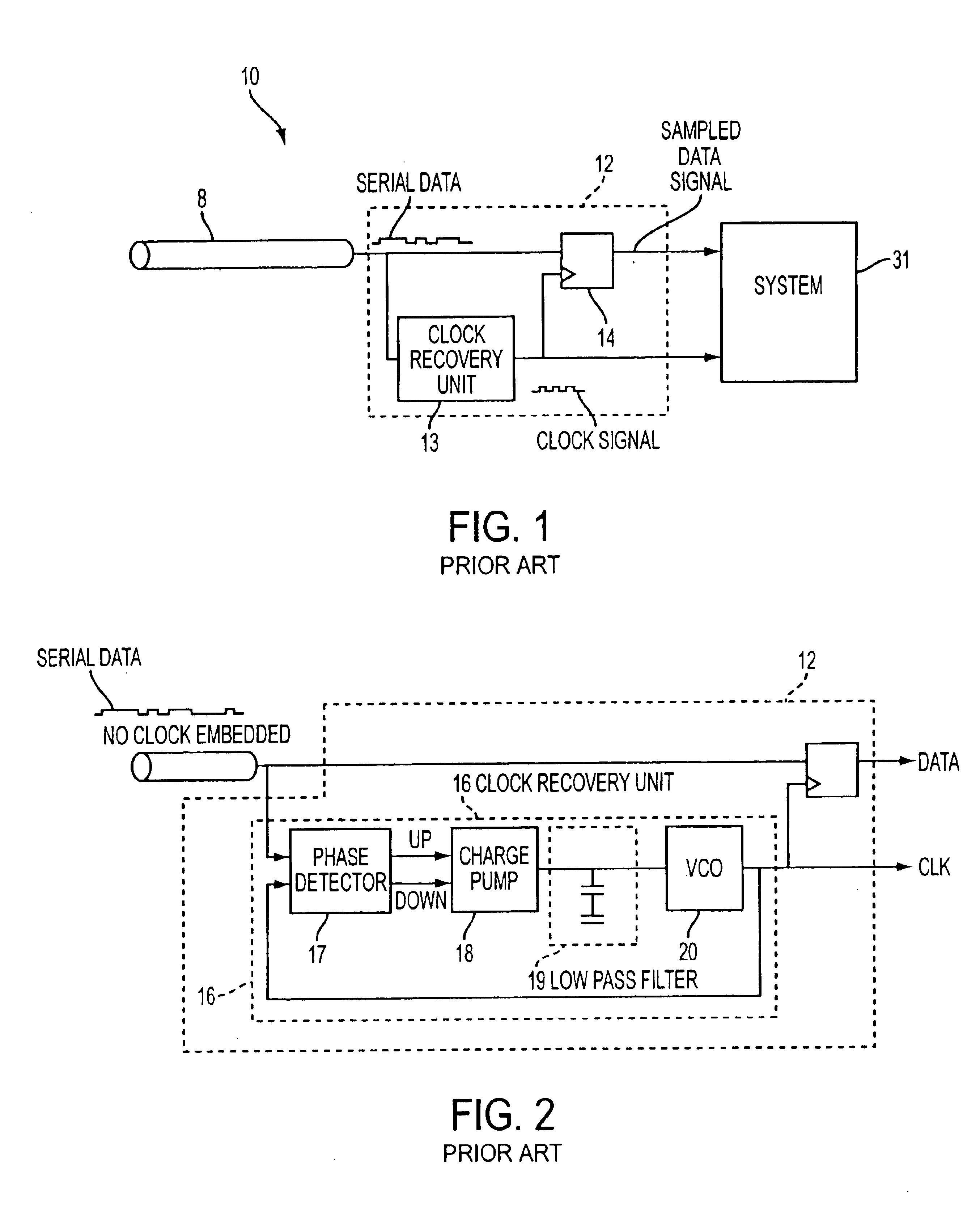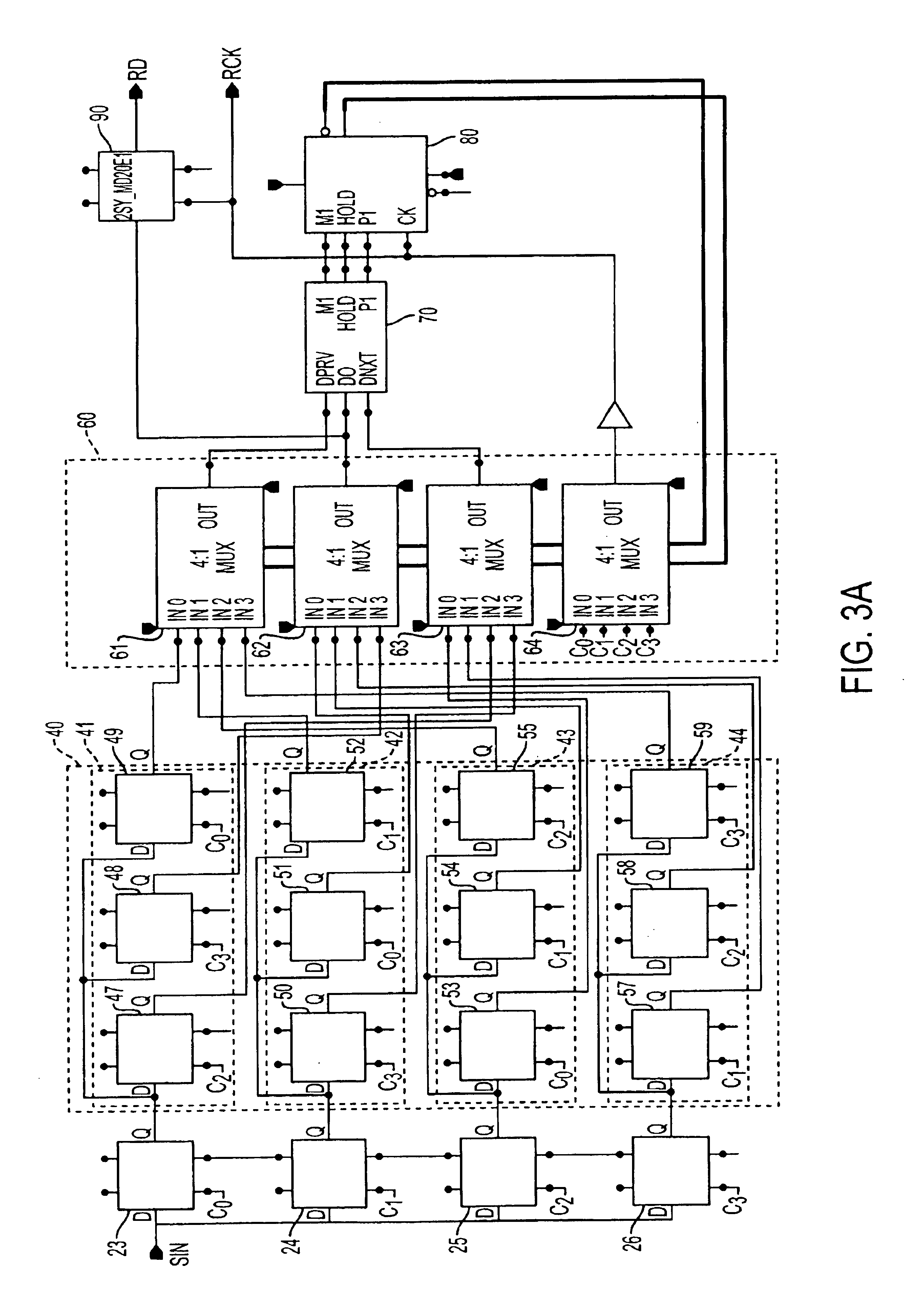Method and apparatus for recovering a clock signal from an asynchronous data signal
a clock signal and data signal technology, applied in the field of system and method for recovering asynchronous digital data by a receiver, can solve the problems of data loss, inability to implement a clock signal having the necessary 4 frequency in an ic, and inability to achieve high frequency signals. practical and cost-effective design
- Summary
- Abstract
- Description
- Claims
- Application Information
AI Technical Summary
Benefits of technology
Problems solved by technology
Method used
Image
Examples
fourth embodiment
[0037]FIG. 21 is an exemplary embodiment of the barrel shifter unit utilized in the present invention.
[0038]FIG. 22 is an exemplary embodiment of the multiplexer 541t utilized in the fourth embodiment of the present invention.
[0039]FIG. 23 is an exemplary embodiment of a latch circuit utilized in the fourth embodiment of the present invention.
[0040]FIG. 24 illustrates an exemplary embodiment of an error detection circuit utilized in the fourth embodiment of the present invention
[0041]FIGS. 25a-25g are exemplary timing diagrams illustrating the operation of the fourth embodiment of the present invention.
[0042]FIG. 26 is a timing diagram illustrating one of the problems solved by the fourth embodiment of the present invention.
DETAILED DESCRIPTION OF THE INVENTION
[0043]FIG. 3a illustrates an exemplary embodiment of the clock recovery system of the present invention. As shown, the system 100 comprises a multi-phase sampling unit 22, which comprises four latches (e.g., d-type flip-flops)...
first embodiment
[0074]The output of each of the four phase decoders 111-114 is generated in accordance with the table illustrated in FIG. 5. Thus, each individual phase decoder 111-114 contained in the phase decoder 110 functions in the same manner as the phase decoder described in conjunction with the As shown, the outputs of the first phase decoder 111, M1, Hold and P1 are coupled to the IN0 inputs of multiplexes 121, 122 and 123, respectively, which are contained in the multiplexer circuit 120. Similarly, the outputs of the second phase decoder 112, M1, Hold and P1 are coupled to the IN1 inputs of multiplexes 121, 122 and 123, respectively. The outputs of the third phase decoder 113, M1, Hold and P1 are coupled to the IN2 inputs of multiplexes 121, 122 and 123, respectively. Finally, the outputs of the fourth phase decoder 114, M1, Hold and P1 are coupled to the IN3 inputs of multiplexes 121, 122 and 123, respectively. The outputs of multiplexers 121, 122, 123, are coupled to the M1, Hold, P1 i...
second embodiment
[0075]Thus, in accordance with the operation of the second embodiment, the decoded results of the comparison of samples q0, q1 and q2 are coupled to the barrel shifter 80 by selecting IN0 inputs of the multiplexers 121-123. The decoded results of the comparison of samples q1, q2 and q3 are coupled to the barrel shifter 80 by selecting IN1 inputs of the multiplexers 121-123. The decoded results of the comparison of samples q2, q3 and q0 are coupled to the barrel shifter 80 by selecting IN2 inputs of the multiplexers 121-123. Finally, the decoded results of the comparison of samples q3, q0 and q1 are coupled to the barrel shifter 80 by selecting IN3 inputs of the multiplexers 121-123.
[0076]The multiplexer circuit 120 of the second embodiment further comprises an additional two multiplexers 123 and 125. Multiplexer 124 receives samples q1c0, q2c1, q3c2 and q0c3 at input lines IN0, IN1, IN2 and IN3, respectively. The output of multiplexer 124, which is controlled by the barrel shifter 8...
PUM
 Login to View More
Login to View More Abstract
Description
Claims
Application Information
 Login to View More
Login to View More - R&D
- Intellectual Property
- Life Sciences
- Materials
- Tech Scout
- Unparalleled Data Quality
- Higher Quality Content
- 60% Fewer Hallucinations
Browse by: Latest US Patents, China's latest patents, Technical Efficacy Thesaurus, Application Domain, Technology Topic, Popular Technical Reports.
© 2025 PatSnap. All rights reserved.Legal|Privacy policy|Modern Slavery Act Transparency Statement|Sitemap|About US| Contact US: help@patsnap.com



